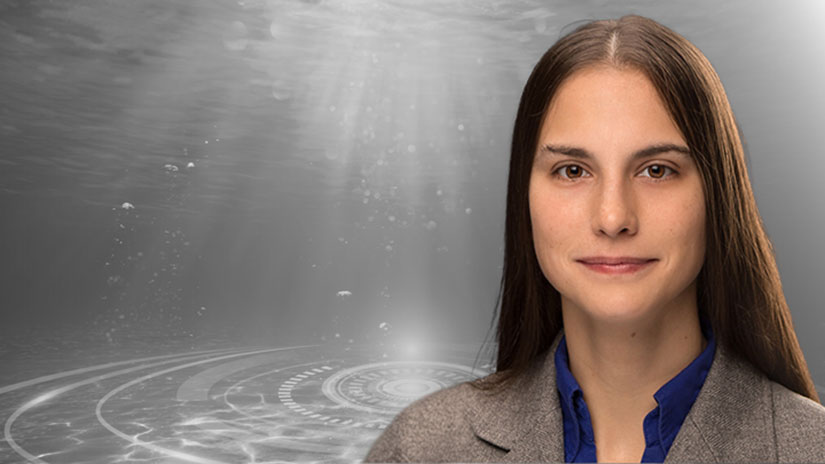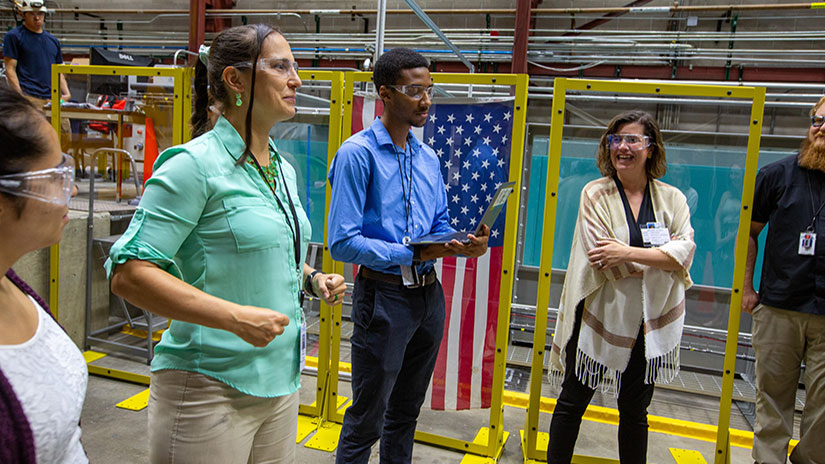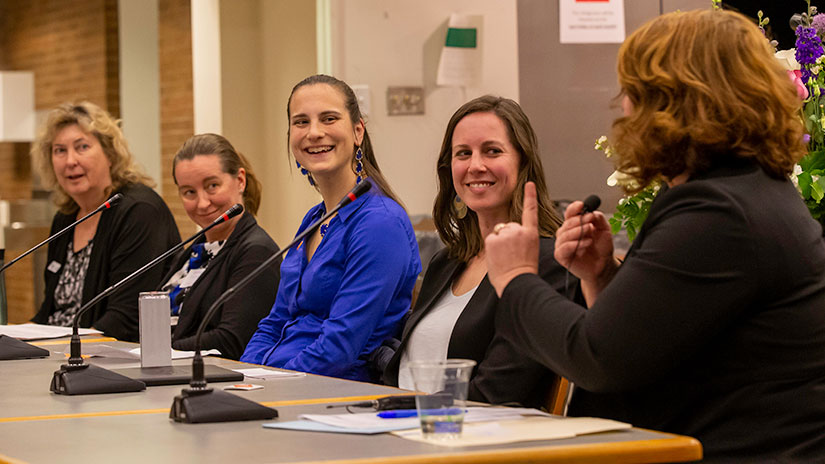Beneath the Surface: Nicole Mendoza Is a Supersonic Environmentalist
She Is Fueling a Brand of Extra-Sustainable Clean Energy, Like Wave Energy Devices Disguised as a Seaweed Forest

Around 1980, the Earth’s temperature shifted from a steady uphill stroll into an all-out sprint. That scary shift demanded quick action, and many concerned scientists relied on one common argument to try to raise the alarm: The environment, they argued, benefits humans. We eat and drink from its bounty, build our cities from its resources, and find new medicines in its plants and animals. In short: We should protect the environment, so we can use it.
Nicole Mendoza is not keen on this human-centric rationale.
“I’ve always felt a very strong connection to nature. Not just seeing it from the ‘how it can help humans’ perspective but actually valuing it for what it is in and of itself,” Mendoza said. “It’s just inherently and innately beautiful and worth protecting.”
Mendoza, an aerospace engineer at the National Renewable Energy Laboratory (NREL), has felt this strong connection to nature ever since she learned about kingdoms and classes, disappearing rainforests, and why toads differ from frogs. She spent much of her pre-smartphone childhood outside: She camped in forests with the Girl, Boy, and coed Venturing Scouts, rode horses through golden fields, and waded into Texas’ Galveston Bay, leading volunteers to plant seagrass and clean up old crab traps to restore the state’s largest estuary.
Now, at NREL, Mendoza builds novel technologies that can help protect the “wonderful, beautiful blue marble that we all share,” as she puts it. She is working to create more efficient offshore wind turbines, improve water equity with help from hydropower, and redefine what makes technology ready for commercial use (adding, for example, social and life-cycle environmental impacts). She is also designing a kelp-like marine energy device that could generate energy from the ocean while restoring ecosystems. A forest of these devices could, for example, act as an artificial reef, attracting phytoplankton, which brings shrimp and finally fish.
“My vision is that this technology helps build the ecosystem from the ground up,” Mendoza said, “being beneficial to the environment, not just neutral.”
But finding a career where she could translate her love of nature into practical, ecosystem-saving solutions was not always easy for Mendoza. First, she wanted to be an ornithologist or a marine biologist.
“I was super into birds and flying—just the majesty and wonder of flying,” Mendoza said. “I wanted to swim with the dolphins and play with the otters and swim alongside the whales and snorkel with the fish.”
She also wanted to jump with the horses.
Growing up, Mendoza’s godmother had three horses. And the budding environmentalist bathed, groomed, watered, and fed them, mucked their stalls, and prepped them for shows. (She even competed in some shows, trotting the horses around the ring, like oversized dogs in a dog show).
“So, I was going to be a horse vet. That’s what I had decided,” Mendoza said.
She enrolled in a high school dedicated to aspiring medical professionals. But all she did was memorize maladies—like acariasis, pyemia, and seroma—and their treatments. “I wasn’t learning much, mostly memorizing, and it would only get worse,” Mendoza said. “So, I made a hard switch to engineering to better understand how the world works.”
Naturally, she chose environmental engineering first. But soil pH, grasses, and wastewater treatment did not excite her either. Mendoza wanted something a bit spicier.
And she got it in a scramjet.
Mendoza (second from left) is a “scrappy researcher,” according to one of her colleagues,
earning funding for a vast range of projects. She is the kind of relentless environmentalist
the planet needs. Photo by Taylor Mankle, NREL
“It is pretty freaking fantastic,” Mendoza said. “It’s called a supersonic combustion ramjet, and it’s a type of engine that allows you to travel many times the speed of sound. At those high speeds, the air itself starts to break down.”
Scramjets, the Usain Bolt of jet engines, are built by wrangling some complex aerodynamics, thermodynamics, physics, and chemistry. Nothing about them is simple. Mendoza was in love.
But after earning her bachelor’s and doctoral degrees in aerospace engineering at Texas A&M University, Mendoza realized her supersonic puzzles sped her away from environmentalism and planet-saving work. So, when she got her first job at Boeing, she started out in supersonic and hypersonic jet engines but quickly networked her way over to the environmental performance department. If she was going to stay in aviation, she was going to green it up.
“I want my long hours, hard work, and blood, sweat, and tears to actually mean something and to have a positive impact on the world,” Mendoza said.
Eventually, she jumped to wind energy and, after three years at Siemens Gamesa Renewable Energy as a wind turbine blade designer, she joined the wind and water teams at NREL. In her four years at the laboratory, Mendoza has accomplished a lot. Michael Lawson, a senior researcher in marine energy and manager of NREL’s water power technologies group, calls her “scrappy.”
“Yes, I am a scrappy researcher,” Mendoza agreed.
So far, her ideas have earned her and her colleagues about $135,000 in research funding for water power and $75,000 in wind energy. And her research stretches beyond sustainable technologies: She is working to help build clean and equitable communities, too.
Mendoza (third from left), who identifies as Latina, is heavily involved in a wide
range of diversity, equity, and inclusion efforts at NREL and beyond. She co-leads
the Colorado chapter of the Women of Renewable Industries and Sustainable Energy organization
and volunteers with the Society of Women Engineers and local K–12 schools to help
inspire girls and women to pursue careers in science, technology, engineering, and
mathematics (STEM). “I am very ‘fiery,’ ‘feisty,’ and ‘spicy,’ as Latinas are commonly
stereotyped to be,” Mendoza told the University of Michigan. She was often excluded because of these traits, and she does not want stereotypes,
a leaky STEM pipeline, or microaggressions to hold the next generation back. Photo by Brittany Conrad, NREL
“I’ve taken a really strong intellectual interest in going back to the fundamentals of our society and fixing our food, water, energy, and housing systems,” Mendoza said. “Here, in America, we are having so many issues with these basic fundamental categories.”
Now, Mendoza works on several projects funded through the U.S. Department of Energy’s Water Power Technologies Office. For one, she helped design a new method to evaluate when wave energy technologies are mature enough for widespread use. The new system could supplant the traditional system, known as technology readiness level, which has been the go-to since the 1970s and focuses mostly on whether a technology is ready for commercial use. But there is more to success than just kilowatts, Mendoza said. Her and her team’s Technology Performance Level system considers environmental and social impacts, markets, supply chains, and even a tough-to-survive ocean environment.
Mendoza is also investigating whether a much older technology, hydropower, could help underserved communities access clean water. “Water equity and water justice are broader than just hydropower,” Mendoza said. But because hydropower plants and water supplies are interdependent, these facilities could help provide communities with clean water and create clean, affordable electricity, too. To start, she and fellow NREL researcher David Greene are collecting data on which communities struggle to access affordable water and whether hydropower could help.
But Mendoza might be most excited about her artificial, energy-generating kelp. The technology is based on NREL’s distributed embedded energy converter technologies and connects multiple small fronds of fake seaweed into one bigger power-producing device. Mendoza’s kelp could surge and sway, like the real thing, to harness ocean energy while imitating its namesake. She also plans to construct her kelp from recycled ocean plastic and hopes artificial kelp forests could trap nutrient-dense sediments. If so, these forests could create new habitats and protect coastal communities: A sediment barrier could reduce erosion and soften ferocious waves before they hit shore.
Although these benefits are still theoretical, Mendoza’s kelp is not: The first prototype endured its first test in NREL’s wave tank last summer, and she plans to dunk them again in January 2024.
“I am doing my best to design it to be synergistic with the environment and be as sustainable as possible,” Mendoza said.
After all, it seems appropriate that Mendoza would end up imitating her beloved nature in order to save it.
Discover all the ways NREL’s experts are inspiring the next generation of clean energy champions to save the planet. And subscribe to the NREL water power newsletter, The Current, for the latest news on NREL's water power research.
